Remember when procurement meant endless email threads about vendor contracts and finance teams drowning in spreadsheets? That world is vanishing faster than a purchase request with no ROI attached. While 2024 saw companies slash budgets and scrutinize every dollar spent, the landscape is shifting dramatically. Recent research we did with CFO Dive revealed that 70% of finance executives increased their spend management software investment compared to last year – yet remarkably, 60% still allocate less than 10% of their software budget to these critical tools.
As we barrel toward 2025, this imbalance is about to change radically. The signs of transformation are everywhere: 99% of finance executives use data and insights to inform spend management decisions, while 83% have automated approval processes covering at least 75% of their spend. But 2025 will bring even more meaningful changes.
From AI that doesn't just crunch numbers but prescribes actions, to CFOs morphing into chief fluidity officers, here's our analysis of the procurement trends and shifts that will define the year ahead.
1. AI Will Kill the "Procurement Department" — and Save It at the Same Time
The impact of artificial intelligence on procurement and finance will be profound and far-reaching in 2025. As Dave Campbell, Tropic CEO, observes: "AI-powered spend management tools will render tactical procurement roles obsolete. However, procurement leaders who lean into AI and automation will see their function evolve into a strategic powerhouse — driving savings, supplier innovation, and business resilience."
"The days of chasing spreadsheets and managing reactive, manual RFPs are over. AI will handle the grunt work, freeing procurement professionals to focus on relationships, negotiations, and big-picture decisions. Those who don’t adopt this mindset will struggle to justify the function altogether," Campbell explains. "The real differentiator will be talent. Professionals who embrace AI will elevate their careers, becoming indispensable advisors who bridge technology and business impact. Those who don’t will struggle to justify their roles as value creation replaces process management. Adaptation isn’t optional. For procurement and finance, leaning into AI is the path to thriving in the next era of spend management.”
2. AI Will Shift From Reactive to Proactive in Spend Management
This transformation won't stop at basic automation. Campbell predicts: "While AI tools today excel at identifying trends and making reactive predictions (e.g., forecasting spend or variance analysis), 2025 will see a major shift towards proactive and prescriptive AI. This next step means AI will not only surface insights but actively recommend next steps and even automate actions, such as suggesting optimized contract terms or flagging redundant vendor relationships. Procurement and finance leaders who embrace AI-driven recommendations will move faster and make smarter, data-backed decisions without sacrificing control.”
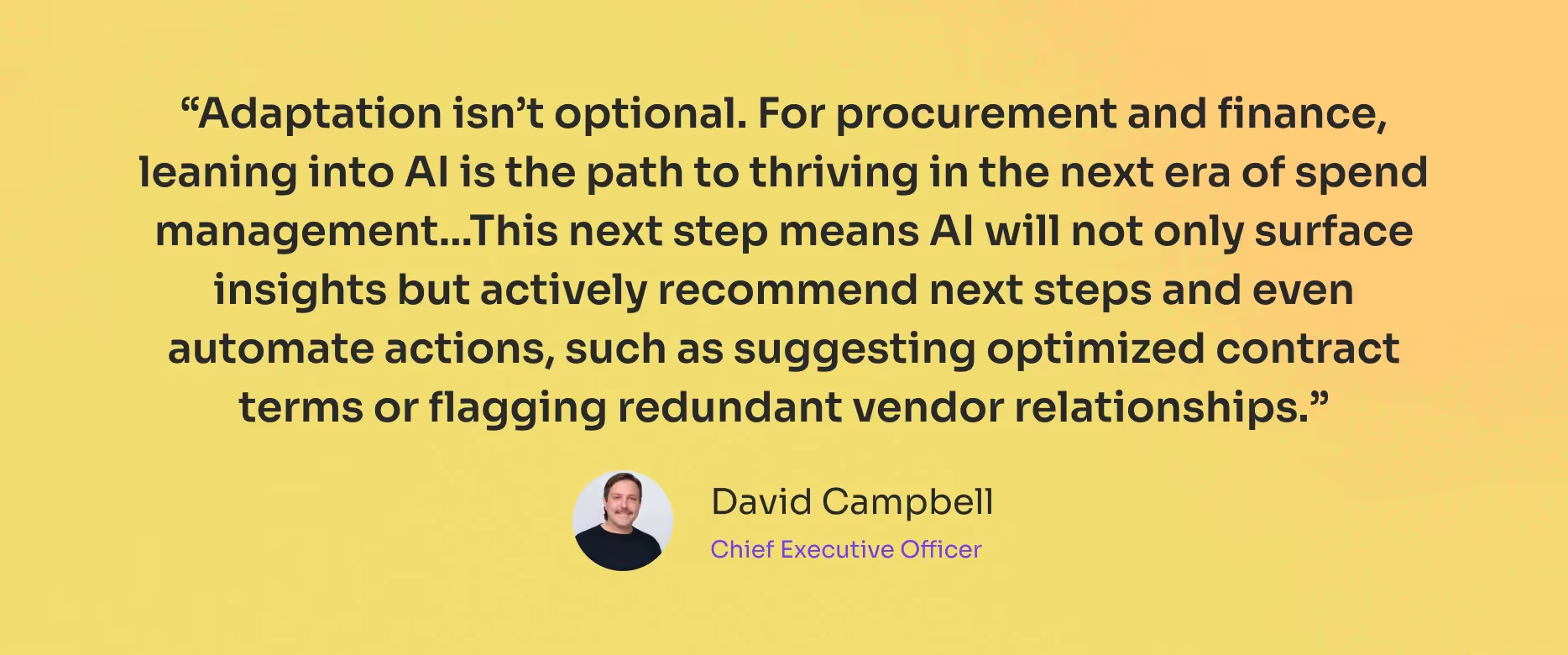
3. Tools that Surface “AI in Context” Will Rise to the Top
The way organizations implement AI will be crucial to its success. Russell Lester, Tropic CFO, emphasizes the importance of seamless integration: "Tools that embed AI into existing workflows—what we call "AI in Context"—will take precedence over standalone AI solutions. For finance and procurement, this means AI within FP&A systems, ERPs, and spend management platforms will surface contextual, actionable insights without disrupting current processes. Imagine an FP&A tool that automatically identifies anomalies in headcount forecasts and flags hiring redundancies before budget overruns occur. It’s for this reason that we created Ask Tropic to enable users to ask natural-language questions about vendors, contracts, and benchmarks directly within their platform.”
4. Automation of Repetitive Financial Tasks Will Unlock Bandwidth
This integration will have a profound impact on junior roles. As Lester notes: "In 2025, repetitive and manual financial tasks—like data aggregation, basic variance reporting, and initial root-cause analysis—will be automated with AI. This will free up junior finance and procurement professionals to focus on higher-value work like strategy and decision support. This also means the roles of junior finance and procurement professionals will shift toward AI tool mastery. The ability to leverage, validate, and interpret AI outputs will become a core skill for rising talent in these functions.”
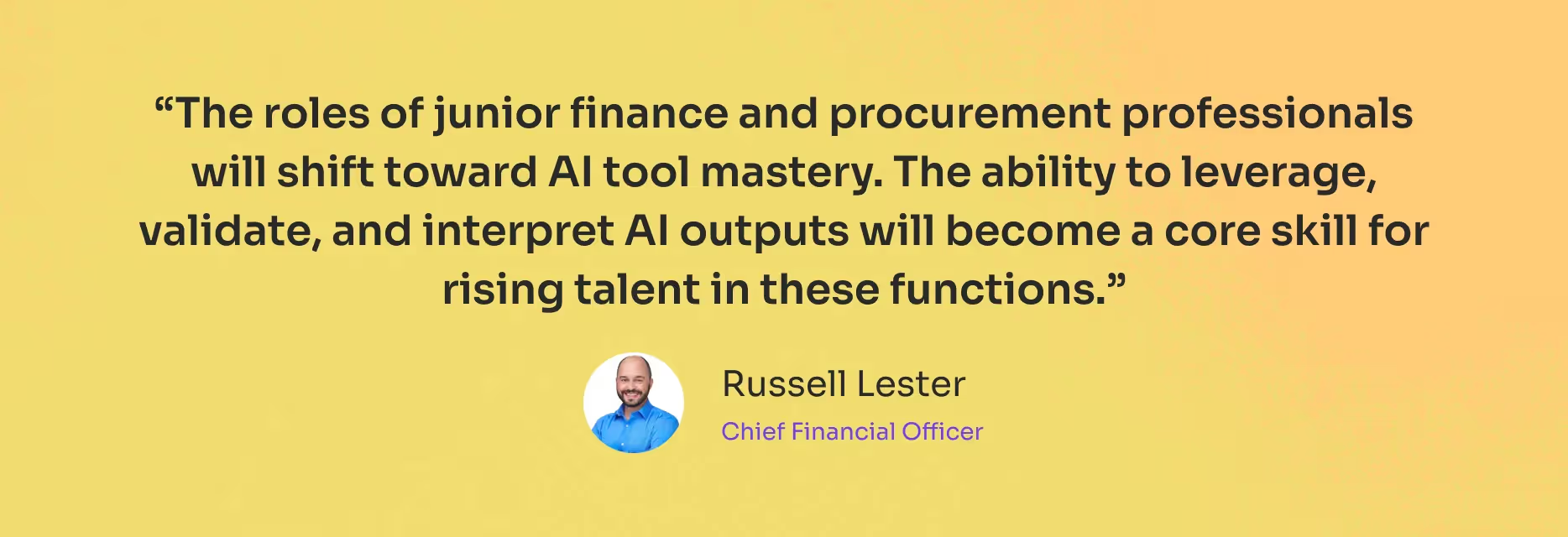
5. The CFO Will Become the “Chief Fluidity Officer”
The role of financial leadership is evolving to meet new challenges. Justin Etkin, Tropic COO, predicts: "While many feel the worst is behind us, 2025 is still riddled with uncertainty. The CFO will be the strategic force in the C-suite, determining which bets to fund and which to deprioritize. With an ever-evolving technology landscape, CFOs will need to rapidly respond to changing circumstances - ready to quickly shift resources when necessary, while keeping their companies organized and aligned. The best will trade in their typical steadiness and consistency for the agility and decisiveness necessary in today’s landscape. CFOs are no longer simply responsible for predictability in spend and revenue, they’re strategy architects. Procurement teams, technology spend, and vendor strategy will be key levers in this shift."
6. The New KPI: "Spend ROI per Employee"
This evolution will bring new metrics and methodologies. Etkin believes "companies will adopt a new north star metric for efficiency: Spend ROI per employee. This will measure the impact of every dollar spent relative to the resources it enables — ensuring budgets are lean, investments are strategic, and employees are empowered. Leaders will move away from blunt cost-cutting to a more sophisticated mindset: How can we allocate spend to maximize productivity and employee outcomes? This will reshape budgeting, procurement, and decision-making across the org.”

7. Cost Optimization Will Drive Investments
The approach to cost management is becoming more sophisticated. Michael Shields, Head of Procurement and Strategy at Tropic, explains: "In 2025, the focus on cost reduction will evolve into cost optimization as businesses prioritize investments that drive growth. Following a year of aggressive cost-cutting in 2024, many SaaS companies are seeing a rebound. As such, they are balancing tight budgets with the need to grow - thereby shifting their mindset to strategically invest where the return on investment (ROI) is clear and aligned with key financial metrics like EBITDA and profitability.
Procurement will play a central role in ensuring these investments deliver measurable value by partnering earlier with stakeholders and focusing on outcomes that enable innovation and efficiency. For industries like SaaS, where growth is accelerating and the IPO pipeline is strong, procurement leaders will scrutinize spend decisions to validate usage, ROI, and long-term value. Sales teams, in turn, will need to adapt by demonstrating quantifiable benefits and positioning their solutions as essential tools for solving clear business challenges.”
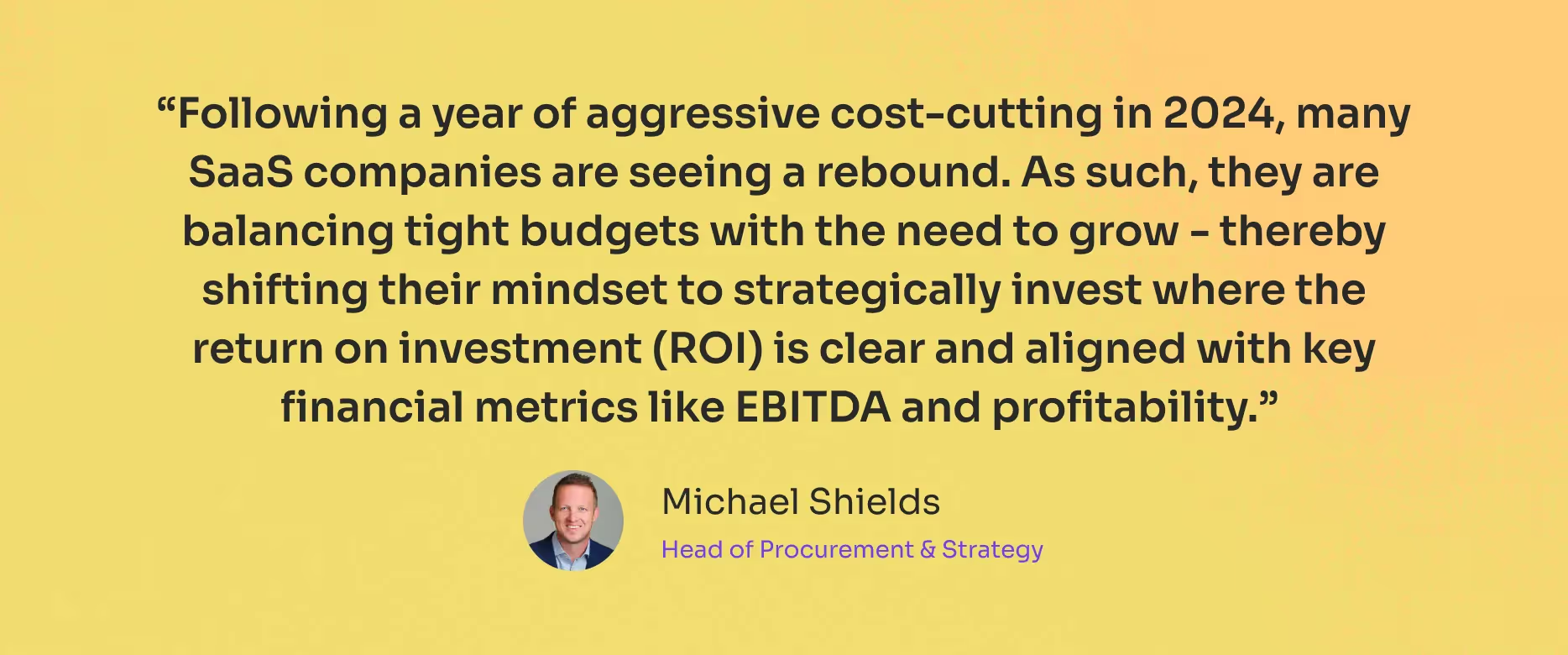
8. Vendor Consolidation Will Accelerate to Enhance Supplier Leverage
This strategic shift extends to vendor relationships. Shields says "Organizations will accelerate vendor consolidation, focusing on partnerships with suppliers that leverage AI to enhance innovation, efficiency, and scalability. The trend toward “buying only what is needed” in 2024 will evolve into a more strategic approach, with procurement leaders identifying opportunities to consolidate overlapping suppliers and optimize spend.
Leveraging advanced tools and market intelligence, businesses will rationalize their supplier base, enhancing negotiation leverage and improving supplier performance. This shift toward AI-driven tools will place increased pressure on suppliers to differentiate themselves through innovation, tailored solutions, and exceptional service. For procurement, the outcome will be stronger, more efficient supplier relationships, delivering both cost savings and value beyond the bottom line.”
Looking Ahead in 2025
The office of the CFO of 2022 or 2023 would barely recognize its 2025 counterpart. Gone are the days of tactical purchasing and reactive vendor management. As Russell Lester puts it: "Finance executives are realizing that if you look into your investments more deeply and optimize where you're spending your money, you're driving growth as well as back-office efficiency."
Tomorrow's procurement and finance leaders will be strategic architects, wielding AI tools to shape business outcomes while building deeper, more valuable partner relationships. The winners won't just be the ones who cut costs or automate processes – they'll be the ones who transform procurement and finance into catalysts for innovation, growth, and resilience.
For those ready to embrace this future, the opportunity is enormous.
Related blogs
Discover why hundreds of companies choose Tropic to gain visibility and control of their spend.





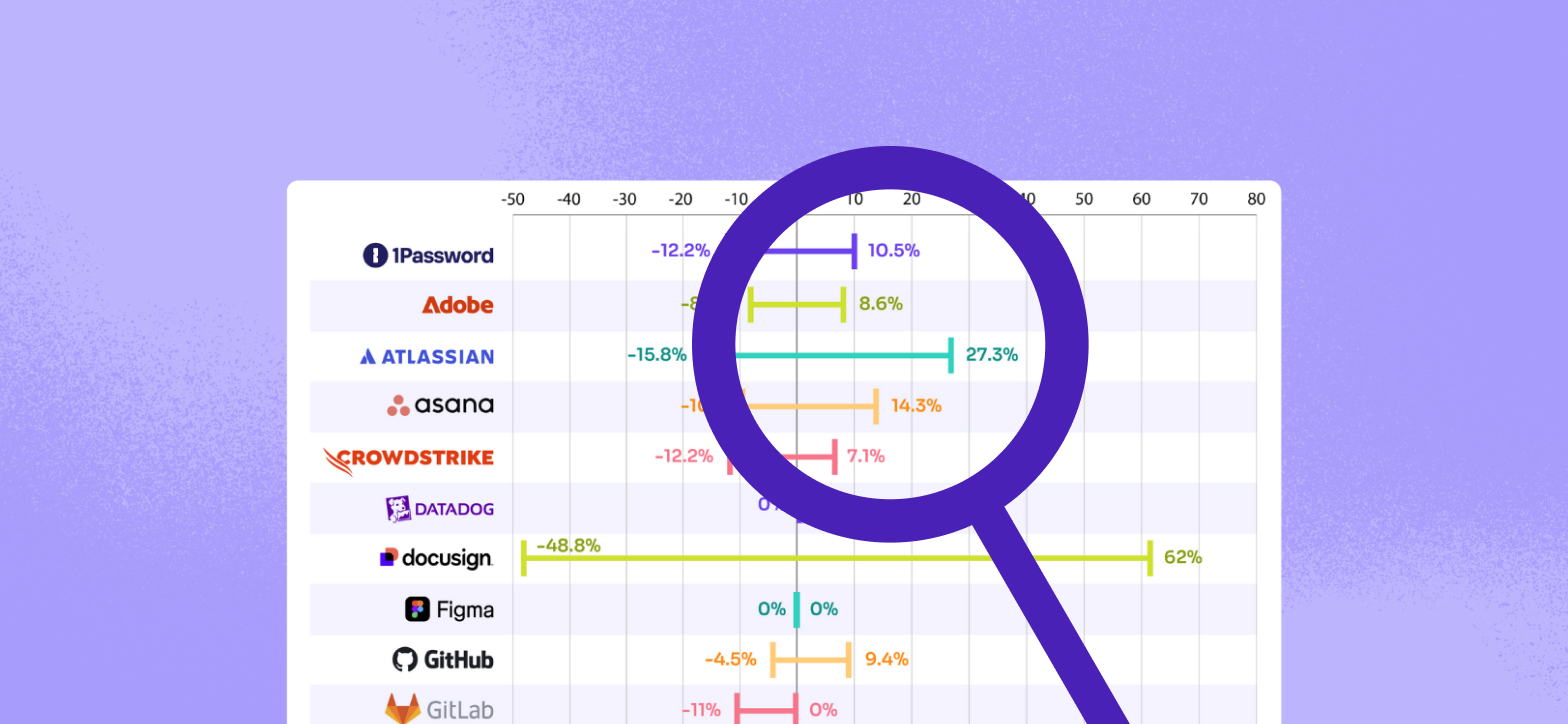
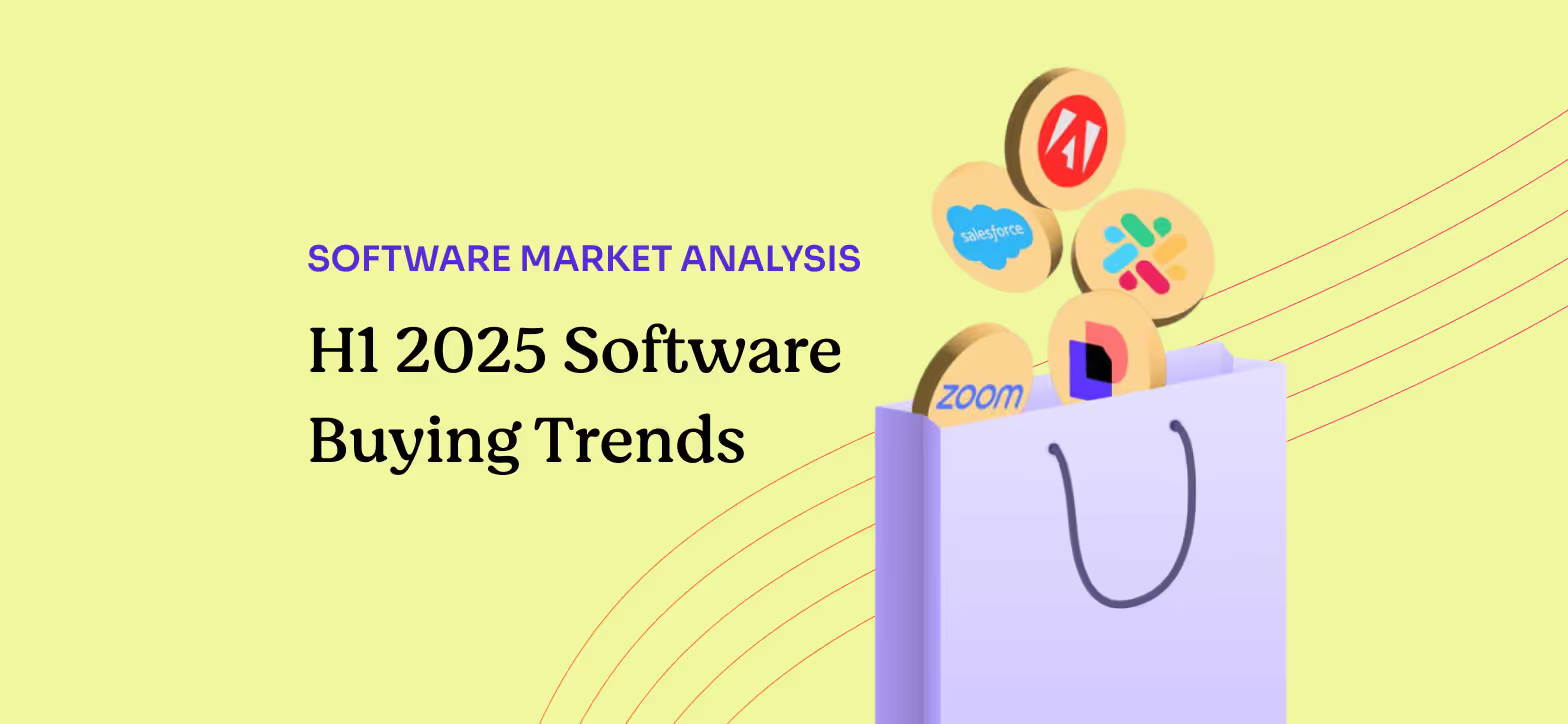

.avif)